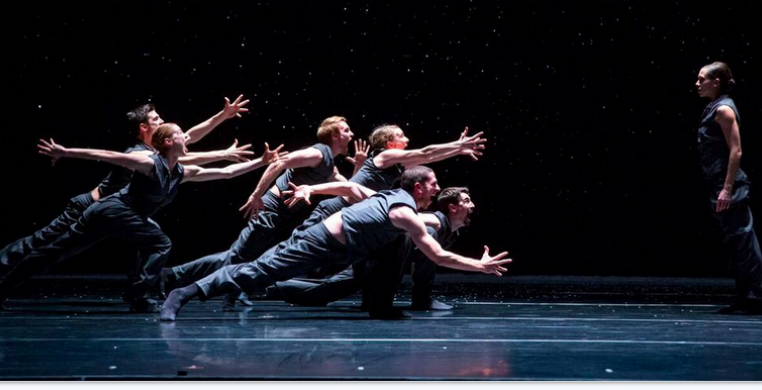UPDATE: The new seechicagodance.com will launch March 31st. Click here to learn more.
Poetic contrast in Hubbard Street's winter series at the Harris
Hubbard Street’s winter series was about the dancers, their splendor as an ensemble maturing with each season, their strengths as individual artists a delight to behold. This past weekend saw both the main company and Hubbard Street 2 in a program of four works, the whole of which demonstrated the expressive range and stylistic flexibility that is a hallmark of this company’s eclectic repertoire.
Yin Yue’s “A Glimpse Inside a Shared Story” (premiere) gave HS 2 a dynamic canvas to unleash plenty of high energy and interpretive chops between the three women and two men in ever-running perpetual motion. The percussive beat of a street-smart musical patchwork saw contrasting fluid and broken movement, from a break dance feel of exposed nerves and extreme angles to the fluid undulations of squiggle arms and melting torsos. The piece seemed to be exploring where the human body can go within itself in a script of complex interior dialogues comprised of swiftly-morphing solos, duets and quartets that asked, “How do bodies couple and part?” Julie Ballard’s dramatic lighting discovered chiseled lines and fleeting interactions, almost as if the light itself were a supernal partner to each of the seven flesh and bone dancers. Arms and legs seemed to puncture space, then swing and circle with the momentum of body weight and breath in organic progressions beginning in shoulders and arms and sweeping out through expansive leg arcs. The piece became increasingly fluid as it reached its culmination in a visually arresting mis en scène.
Robyn Mineko Williams’ “Waxing Moon” (2014), originally set on the company last winter for the Princess Grace Awards: New Works concert, received a welcome reprise in a deeply-moving performance by Andrew Murdock, Jacqueline Burnett, and Jason Horton. Burke Brown’s lighting design defined both physical and psychological space. Murdock, isolated in a rectangle of light on a folding chair, wages an inner struggle of being as he observes Horton and Burnett, separated center stage in their own lit space, engaged and vital in their interaction. Murdock ultimately joins them in a trio of transformation. Then, with a gorgeous duet in the healing hands of the lovely Ms. Burnett, he finally reaches what seems to be personal equilibrium. The piece suggests the drama of relationships, even a history of love lost and rediscovered, or the shifting aspirations of a modern day Hamlet who can imagine action and yet remains paralyzed within himself. It is almost as if Horton is another self, bare and exposed, his naked upper body in contrast to the fully-clothed Murdock. The lyrical movement is all action/reaction with rich interior monologues and beautifully defined character arcs for each of the three.
“Out Of Keeping” (premiere) paints the stage with four rippling couples in Penny Saunders’ cannon of color-coded duets. Branimira Ivanova’s simple, gender-specific bodysuits maximize line and highlight individual dancers. It is always a treat to watch Kelly Epperheimer and Jesse Bechard, paired here in grey/green. Swift-flowing crossings with athletic running connected choreographed segments. An arm motif of gestural hieroglyphics characterized the largely peripheral movement material, replete with repetitions of wide leg arcs, arm swings, fan kicks, and gestural circling of each others’ negative body space. Saunders’ choreographic voice is in its emerging stage here, with movement that has yet to define itself as specific and meaningful, either as abstract design or emotionally compelling relationship. Despite the generic modern dance feel of the whole, the piece still gave the Hubbard Street dancers competently structured, very danceable material that allowed them to hold interest with their marvelous execution.
The highlight of the evening was Crystal Pite’s “Solo Echo” (2012), originally created for Nederlads Dans Theater and set this season on Hubbard Street, the first U.S. company to perform it. Poetic contrast infuses Pite’s vision and concept in every aspect of “Solo Echo.” The achingly poignant visual design of falling snow, silent across an upstage field, and the soulful beauty of Brahms’ sonatas for cello and piano stung the rawness of Bechard’s opening gesture of wide-spread arms and high arched chest with the conflicting drama of desperation and inevitability. A stop-start group motif of the race-runner’s pose, elbows bent, one arm back, one forward with outstretched fingers, launched movement into a frenzy of lifts, spins, racing, and halting. The violence of the movement embodied a wrenching love of life, the pulling of resistance and the capitulation of falling. The overall visual design in group work with encircling chains of arms breaking and recombining, a cannon of hands to cheeks, the combative interchange of running and pushing to fall, halting, mouths agape, in astonished surrender all combined to create an existential tour de force in movement. Pite’s use of the poem, “Lines For Winter” by Mark Strand appears in full in the program. An except from the poem captures a bit of the choreographic poetry Pite achieved on stage:
"Tell yourself
as it gets cold and gray falls from the air
that you will go on
walking, hearing
the same tune no matter where
you find yourself--....
....And if it happens that you cannot
go on or turn back
and you find yourself
where you will be at the end,
tell yourself
in that final flowing of cold through your limbs
that you love what you are."
(From Selected Poems, 1979 by Mark Strand and published by Alfred A. Knopf)

